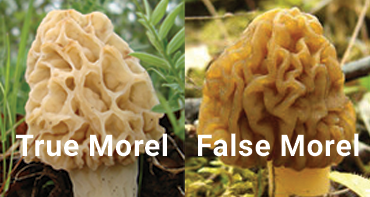Caution: Be careful when foraging for mushrooms of any kind. There are a number of poisonous mushrooms out there. Always cook the mushrooms before consuming to get rid of any toxins. Otherwise you risk stomach illness, or even death. Cook different species you have foraged separately. Never together.
The morel is more related to the truffle than it is to other mushrooms and, like truffles, is the fruit of a fungus that sprouts in the moist soil of woods and forests.
Morels have a unique, subtle, and complex flavor that's often described as earthy, nutty, woodsy, and toasted. They have a meaty texture that's tender but not chewy or squishy, and darker morels can have a hint of smokiness.
Morels begin to grow each Spring, when ground temperatures reach 11.7 degrees Celsius or 53 degrees Fahrenheit.
You can find them in areas of moist soil in woods or forests, often under the stumps of trees that have fallen, near creek beds and river bottoms, and disturbed landscapes found near old burns and logging sites.
Morel mushrooms feature distinct pitted caps with an irregular honey-combed or spongelike appearance. True morels can also be identified by their hollow stems and caps, which are fused at the base to form a continuous hollow.
There are several species of morels ranging in color from yellow, yellow-brown, brown, olive, to gray and grayish-black.
They are best served fresh, but can also be dried very easily, allowing them to be stored for use in the summer, fall and winter months.
Drying morels
Oven - Preheat the oven to 130–175°F and dry the morels on a baking sheet for 2–8 hours, or until they are brittle.
Dehydrator - Set the dehydrator to 110–125°F and dry the morels for about 10 hours, or until they are crispy. Make sure to select morels of the same size for each level of the dehydrator.
Air dry - After cutting the morels in half and soaking them in water for about 30 minutes to remove dirt and bugs, you can string them together so they don't touch and hang them in a cool, dry place out of the sun. This method can take about three weeks.
Storage
Once dry, you can store the morels in an airtight container at room temperature for up to six months, or in the freezer for longer storage. To rehydrate, you can put them in a bowl and cover them with water, and let them sit for about 20 minutes until they are soft and pliable.
False morels are toxic and should not be consumed, cooked or uncooked. Gyromitrin is a toxin found in some varieties of false morel mushrooms and it has been linked to several cases of mushroom poisoning and can be fatal even in relatively small amounts.
False morels have lumpy caps with a brain-like, folded or wrinkled texture. False morel caps can be black, grey, white, brown or reddish. Their cap surface differs from a true morel because they do not have pits and ridges. They bulge outward instead of being pitted inward.
📢 Be careful when out foraging for wild mushrooms. Some wildlife predators eat them too. While you are busy focusing on the mushrooms, a predator may be stalking you. People have been known to disappear while out foraging for mushrooms and berries.


